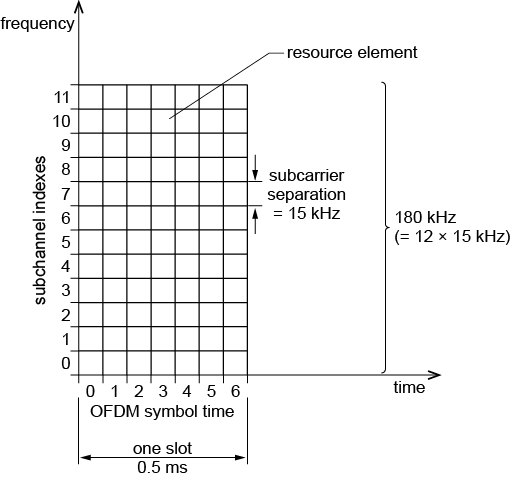4.5 4G mobile broadband
Fourth generation (4G) mobile communication is regarded as part of a so-called Long Term Evolution from 3G, and is often referred to as LTE, or 4G LTE. It was the first mobile communication system designed only for data (as opposed to 3G’s voice-and-data design, and 2G’s voice-only design on to which a data service was grafted). The radio bands used are generally in the region of 800 MHz, 1.8 GHz, 2.1 GHz and 2.6 GHz.
4G uses OFDMA in the downlink (from the base station to the user). The uplink (from user to base station) uses the related Single Carrier Frequency Division Multiple Access (SCFDMA), which is more energy-efficient. (SCFDMA is not covered here.) The uplink and downlink generally occupy different frequency bands, in common with the widely adopted versions of 2G and 3G.
All mobile data communication uses the idea of a unit of resource in the downlink. A resource unit is a stream of data allocated exclusively to a user for, typically, a short time. Figure 4.10 represents a resource block used in 4G. Subchannel index numbers are placed up the vertical axis (unlike the earlier diagrams for DSL where they were on the horizontal axis). There are 12 subchannels in the block, each 15 kHz wide, so a block occupies 12 × 15 kHz = 180 kHz of spectrum. A base station might typically use a channel 20 MHz wide, in which case the number of resource blocks available would be in the region of 110.
The horizontal axis in Figure 4.10 represents time, but in units of symbol periods (i.e. symbol duration). Symbols 1 to 6 each have a symbol period of slightly under 71.4 ms. Symbol 0 is given a slightly longer symbol period of 71.8 ms just to make the total slot time up to 0.5 ms. For poorer signal conditions the slot time of 0.5 ms is divided into six symbol periods rather than seven, giving a lower data rate but greater resilience to noise.
Activity 4.2 Self assessment
- a.If 16 QAM is used throughout the resource block in Figure 4.10, how much data does this block convey?
- b.Hence what data rate is represented is represented by a continuous allocation of 1 resource block to a user?
Answer
- a.Each resource element in Figure 4.10 is one symbol in one channel. In 16 QAM a symbol carries 4 bits of data. There are 7 × 12 = 84 resource elements in the block. Each is loaded with 4 bits, so total data is 84 × 4 bits = 336 bits.
- b.Each block lasts 0.5 ms, so there are 2000 blocks per second. A continuous allocation of one block to a user gives a data rate of 2000 × 336 bit s–1 = 672 kbit s–1
The smallest number of resource blocks that can be allocated to a user at any moment (apart from zero) is 6. The shortest duration of an allocation is two slots, or 1 ms. Overall, therefore, the smallest allocation possible is conceptually six resource blocks high and two resource blocks (slots) wide, giving a minimum resource allocation of 12 resource blocks in total (Figure 2.10). The six resource blocks are not necessarily adjacent in frequency.
The 1 ms duration of the minimum allocation is the scheduling interval. At intervals of 1 ms the allocation of resources to users is reviewed, and the resource allocation and modulation methods changed if necessary, for example, in order to take account of changing link quality between base station and user.
Activity 4.3 Self assessment
What data rate does a continuous minimum allocation give if 64 QAM is used?
Answer
Activity 4.2 shows that allocating a single resource block using 16-QAM gives 672 kbit s–1. Whereas 16-QAM gives 4 bits per symbol, 64-QAM gives 6 bits per symbol, or 3/2, or 1.5, times as many as 16-QAM. The minimum allocation is 6 resource blocks, so the data rate is 672 kbit s–1 × 1.5 × 6 = 6.048 Mbit s–1
A user would not get the data rate calculated in the last example for two reasons. Firstly, not all the resource elements in a block can carry user data. Some are reserved for signalling and pilot data, which are needed by the system itself to ensure that it functions properly. Secondly, error control is used, which always results in some redundancy.
The allocation of resources to multiple users on demand is ‘multiple access’, and is a feature of mobile communications system. For example, although 3G used a very different system from OFDMA (called Wideband Code Division Multiple Access, or WCDMA), it too depends on a limited resource being shared out among multiple users. The rapid review and revision of resource allocation as conditions change is a feature of mobile communications and known as scheduling.


